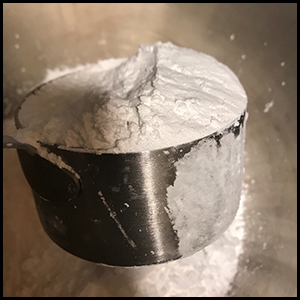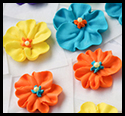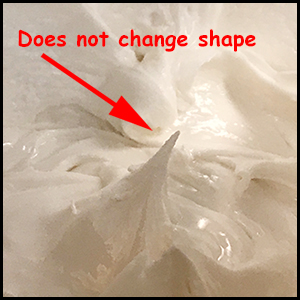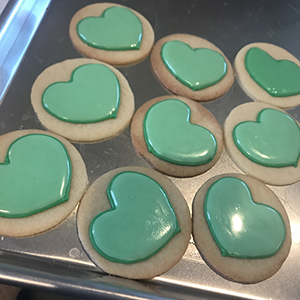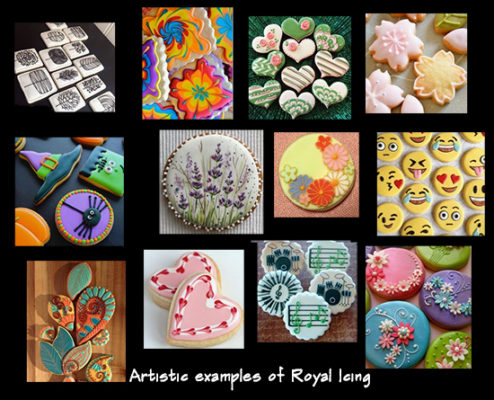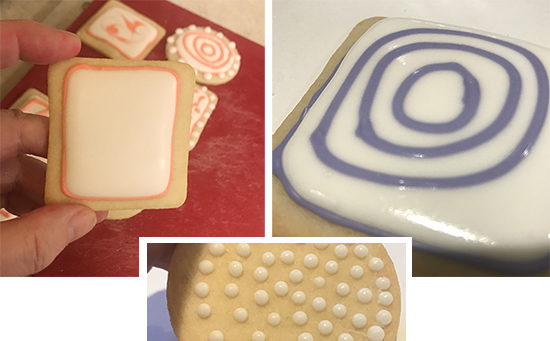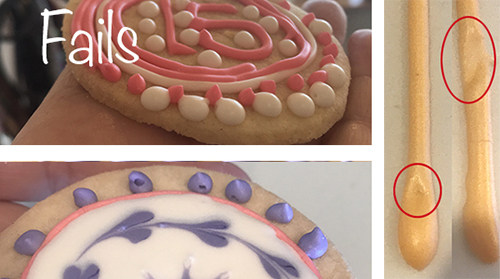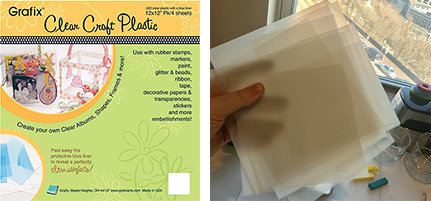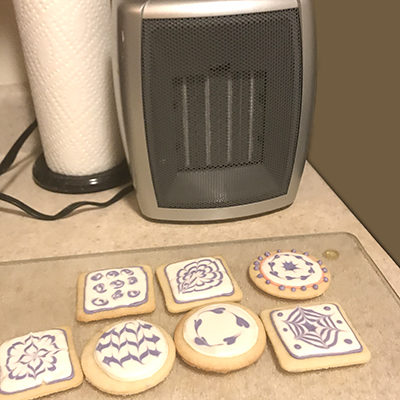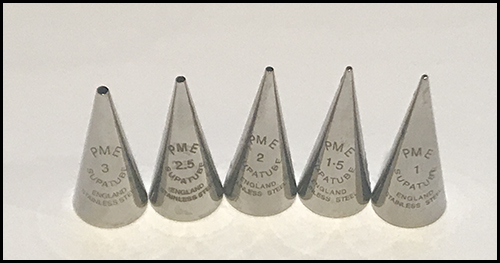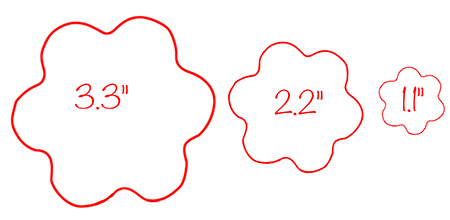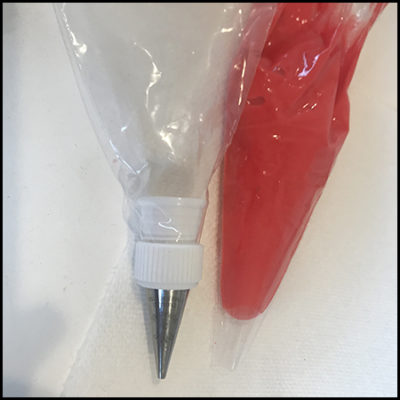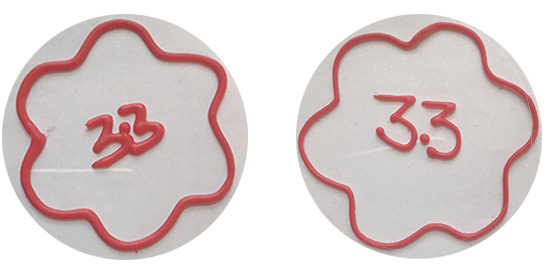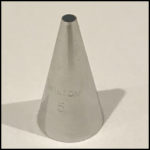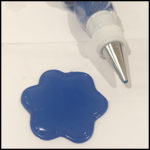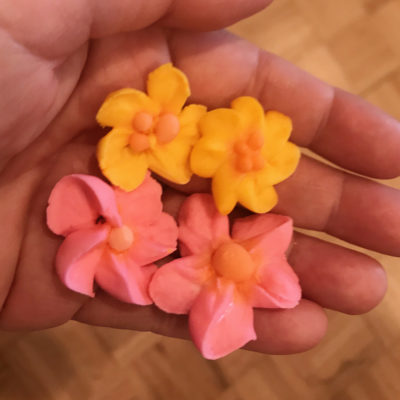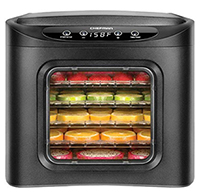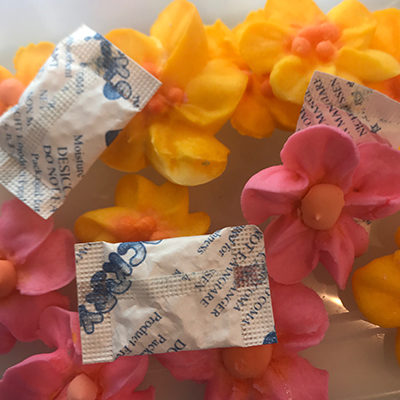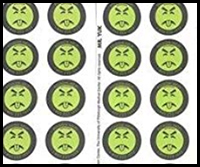Category: Royal Icing and Sugar Cookie Decoration
Royal Icing Recipes (update 8/9/19)
Royal Icing primarily consists of egg whites whipped with powdered sugar, plus a little flavoring,. Unfortunately, recipe directions very greatly as do ingredients which can include raw egg whites, pasteurized egg whites, or dry, meringue powder.
I began making Royal Icing in late 2017 and was disappointed with the results. By mid-2018, I began testing a number of recipes and believe that the one I reproduced here is foolproof.
This recipe contains pasteurized egg whites, fine (10x) powdered sugar, and a touch of flavoring. It dries to a smooth surface, does not bubble under the surface as it dries, does not pit at piping junctures, is easy to flow, and is not dull.
Recipe for a Very Firm Royal Icing
Ingredients:
2 pounds of fine (**10x) powdered sugar or 8 rounded cups of powdered sugar
11 tablespoons (5.5 ounces) of pasteurized egg whites (you’ll find this product where eggs are sold)
2 “slight” teaspoons of flavoring, to taste
Instructions:
There is no order for mixing the ingredients. Simply put them all into a bowl at the same time, then turn your heavy-duty mixer on, using an easy-to-clean paddle beater.
Detail: Start on a low speed so that dry ingredients don’t fly about. Increase the speed to high until everything is pure white. Scrape so there is no loose powdered sugar left on the sides or bottom of your bowl.
There is no exact recipe for making Royal Icing, however, if you prefer to be exacting, measure ingredients by weight.
There is a wide margin for success no matter how much powdered sugar you add with the consistency you need being dictated by the decorating task at hand. This ranges from flow (more liquid) to a very very stiff consistency required for piping shapes, like flowers (more powdered sugar).
Below is a “rounded cup” of powdered sugar you can use for the initial batch.
Objectives:
The consistency (thickness) of the resulting icing depends on humidity in your environment, which adds moisture to your mixture, and the amount of moisture supplied by the egg whites.
The firmer the initial batch of Royal Icing, the better, as the icing can be thinned for a variety of your needs without adding more powdered sugar.
An extremely stiff consistency is used for making structures, like Royal Icing flowers. For more examples than the picture below, check out those made by the Barefoot Baker’s tutorial.
To identify a stiff consistency, stir the batch with a beater or spoon. When you lift the beater up, peaks form that do not bend or change shape. If the frosting flattens or blends even a little bit, it is not truly “stiff.”
A very thick consistency, however, displays a very minor amount of blending and is good for most tasks as it can also be thinned.
To identify a very thick consistency, stir the batch with a beater or spoon. When you lift the beater up, icing peaks form that very, very slowly bend over and eventually sink into a flat surface.
Adjustments are made to portions of the initial batch as your needs dictate.
To increase the stiffness of a portion, add more powdered sugar, a little at a time.
To decrease (moisten) the stiffness of a portion, add water, a little at a time. I recommend you use a glass, food-grade spray bottle to add small amounts of water and not measuring spoons.
Light Corn Syrup:
The addition of light corn syrup to a portion produces a more pliable, elastic mixture that dries to a sheen, like in the photo that follows:
Batches without light corn syrup tend to have a dull surface, like the cookie below:
Light corn syrup is a liquid, so adding it to a portion has almost the same effect as adding water. Blogs by famed pastry implement manufacturer, Wilton, for example, suggest using light corn syrup instead of water to thin Royal Icing. Measurement is a matter of observation based on your consistency needs.
Whether water or a combination of water and light corn syrup, be careful to add it in small amounts because to repair a batch, sometimes a significant amount of additional powdered sugar is required.
I currently use light corn syrup almost exclusively, followed as needed by only a “touch” of water. Corn syrup can be added to an extremely stiff consistency to give the results a sheen, but you run the risk of making your batch too soft to hold shapes.
Eyeball Measurement:
The most foolproof recipe for Royal Icing is the one posted here. When working with it, however, it is up to you to observe its behavior based on your needs.
Flow consistency should not be so moist that it overflows borders or cookie edges.
Piping consistency should not be so dry that you can’t get it through your piping tip, or when you can get it through your tip, not so dry that the extrusion breaks, bunches up, rides up the side of your piping tip, or hurts your hand from squeezing the piping bag.
Extremely stiff or flower development consistency must be dry enough to hold piped shapes, yet moist enough to go through your piping tip. Experiment by adding small amounts of additional powdered sugar until the shapes you pipe hold their own.
Sifting Powdered Sugar:
I have not found it necessary to sift 10X powdered sugar for the recipe I recommend. Even dried bits of powdered sugar will re-moisturize when stirred back into a batch.
I do not use very fine tips. PME #00, or #0, for example, can get clogged. Clogging most commonly occurs during piping, when you set your piping bag aside and the icing in the tip begins to dry out. Work very quickly with small tips to avoid this problem and consider using a smaller amount in your piping bag, which you’ll frequently change, rather than a lot like you would during a flooding operation where icing must cover broad areas.
If you are worried about lumps in your icing, put the icing through a fine metal strainer before filling a bag.
Storage:
Store the icing in an air-tight container. Consider placing plastic wrap over the icing before snapping the top on the container. It can be kept for days in a refrigerator, although the mixture must be vigorously stirred before reuse.
Mixing
The initial batch of Royal Icing is quite thick and demands a heavy-duty mixer. If you are on a budget, the 300 watt, Hamilton Beach 63325 6-Speed Stand Mixer for under $100 is a good buy.
Drying and storing Royal Icing
- Freshly decorated cookies taste best, with my preference being within three days of being iced. Icing on stored decorated cookies becomes harder and more crispy as they age.
- While crispy icing is pretty, pay attention to the quality of your cookie. Cookies exposed to high humidity become limp, with some softness appearing under the icing.
- Royal Icing can be stored in the refrigerator for several days. Place a plastic covering directly on the icing, then seal the container over that covering with an air-tight lid.
- After applying icing to cookies, the best practice calls for drying the icing under a fan. If the icing dents when pressed, it is not completely dry.
- To keep cookies crisp, store iced cookies in an air tight container with parchment paper between them or in individual, air-tight bags.
- Check to make sure there is no condensation in your container or bag when storing iced cookies in the refrigerator.
- If possible, work in an air conditioned environment. Avoid making Royal Icing or frosting cookies with it when the humidity in your environment is high or not controlled. Check your atmosphere on a digital humidity monitor. Even heated rooms can suffer from high humidity, especially a kitchen.
- Under normal to low humidity days, iced cookies can be left out for a few days, during which period the icing becomes harder. On high humidity days, if the cookies are left out, you will lose the cookies’ crispness and possibly destroy your work.
Links
- Pictorial article by SemiSweet (Mike Tamplin), SemiSweetDesigns.com
- Cookie design master, Julia Usher, www.juliausher.com
- Blueprint, formerly Craftsy, has several excellent fee-based courses on the use of Royal Icing on cookies. I learned from
Better Basics for Exceptional Cookies by Stephanie Kappel. Also excellent are courses by Amber Spiegel. Many of the tutorial instructors here also have websites and YouTube videos.
-
Royal Icing with Consistency Adjustments, blog by Julia Usher, www.juliausher.com
-
Toolbox Talk: Corn Syrup in Royal Icing, research article by member LIESBET on “Toolbox Talk,” a site by Julia Usher, www.juliausher.com
-
Make good use of Google and YouTube searches to find numerous articles and tutorials developed by people excited about skill sharing. Royal Icing Tutorials
- How to make a simple Royal Icing primrose, a tutorial by The Barefoot Baker, thebearfootbaker.com.
Article series
To see a list of all articles in this series, CLICK HERE
**Note: 10X refers to a finely milled powder sugar with cornstarch is added to prevent caking.
Questions? Comments? Additions? Corrections? Write to Karen Little at karen@Littleviews.com
Written for Littleviews-Crafts.com by Karen Little, publisher. All rights reserved, but feel free to re-publish this article after contacting Karen so she knows where to find it.
How to Test Royal Icing for Consistency (updated July 15, 2019)
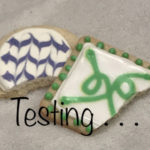
Consistency describes the behavior of Royal Icing required to achieve your objectives. The right consistency is based upon:
<+> Recipe: The behavior and outcome of recipes differs with ingredients and humidity. I personally recommend recipes that contain real egg whites, preferring pasteurized egg whites. (See “Royal Icing Recipes“)
<+> Flatness: Refers to the time it takes for the surface of Royal Icing to flatten, usually indicating how much moisture (water) was added to the mixture. If too much time elapses during the settling process, the surface of the icing begins to harden, interfering with smoothness.
<+> Piping Tips: The ease of extrusion from a very small tip and a large one is different. Icing consistency is often different for different sized tips, with a looser consistency possibly needed for very small tips than for larger sizes.
<+> Humidity: The higher the humidity, the looser the mixture as the icing absorbs atmospheric water.
Examples of Royal Icing Art
When you plan your icing project, be aware that every distinct section of a Royal Icing decorated cookie requires a unique batch of Royal Icing. Each unique batch is defined by consistency (use), its color and possibly the tip sized used to pipe it, with all batches being subsets of the initial batch. A single cookie design, like the green hearts below, might require multiple batches.
Note: Examples from Pinterest
The three examples below demonstrate three different Royal Icing consistencies:
- A flood consistency was used on the white and pink cookie, which dried to a firm, smooth surface.
- A “wet on wet” consistency was used on the white and purple cookie, with the purple sinking into the white icing which resulted in a smooth surface.
- A “dot” consistency was used on the last cookie. This consistency results in dome-topped dots. If peaks appear, the consistency is not correct. Add a tiny amount of water to your mix.
If you do not test all of your design’s batches for consistency prior to using them, sections of your design might fail, rendering overall disappointing results.
Consistency Testing Benchmarks
It would be nice to think that “one consistency size fits all,” but it doesn’t. Even seasoned experts test for the presence of the proper consistencies before beginning their design process. Here is what to look for:
- Flood: This is used to fill large areas. Rather than paying attention to the time it takes to reach flatness, I recommend you test it on a copy of your cookie area or design. If it works as planned, you nailed it. If not, adjust until it does.
- Slightly stiff: This is used to pipe dots or pearls. Again, test to determine whether your dots form domes instead of peaks. If they do, proceed to place dots on your cookies. If not, adjust until they settle properly.
- Flexible: This allows you to easily pipe lines and borders that closely (but not necessarily exactly) retain their extrusion shape.
- Stiff to Extremely Stiff: This consistency does not spread and is used to create flowers, decorative borders, and other shapes. Strangely, this is a difficult consistency to achieve, depending on your need for sharp detail. Often humidity interferes, forcing you to add far more powdered sugar to your base recipe than what you think might be reasonable. If you can barely squeeze your piping bag, your consistency is probably overly stiff, but if detail seems to melt, more powdered sugar is needed. Test, then dry the results. Sometimes what doesn’t look quite right when still moist, becomes perfect an hour later.
Test Your Batches
My article, Royal Icing: Test for Royal Icing Consistency by Using Tiny Piping Cones, describes disposable “mini-tools” for use in consistency testing and they are especially helpful to determine correct dot formation.
Ideally, you can test your batches on cookies, scraping the icing off your samples so you can reuse the cookies. Instead of wasting cookies, however, pipe your samples onto small pieces of heavy paper (like parchment) or plastic. I recommend using twelve-by-twelve inch Grafix Craft Plastic Sheets. Cut the large sheets into smaller sections, then use the sections for test surfaces. The sheets are reusable.
If you have specific designs in mind, print (or draw) them, place them under a plastic sheet, then pipe your design onto the plastic sheet. Make sure all your components have the perfect consistency before proceeding. During the preparation phase, cover your mixtures with plastic wrap, then cover their containers with air-tight lids. The mixtures should stay fresh, however, if you see moisture separation when ready to use, revive by stirring.
Note: It is not necessary to remove the backing of plastic sheets, although re-use over time and washing will cause it to fall off.
Drying Your Royal Icing
A well-tested recommendation is that you dry your iced cookies under a fan, dehydrator, or even a small space heater with fan.
Storing Your Cookies
Humidity affects all baked goods. It makes crisp sugar cookies soft and can interfere with the way Royal Icing is cured.
To refrigerate your cookies, decorated or not, place in a box without closing the lid. Cool them to refrigerator temperature, then cover with an air-tight seal.
To freeze your cookies, repeat the instructions above, but do this in the freezer. When the cookies reach your freezer’s temperature, cover with an air-tight seal.
To defrost your cookies, remove the lid and let them warm up in the refrigerator. When defrosted, you can remove them to room temperature.
Note that it is wise to separate layers of your decorated cookies with parchment which will help prevent sticking.
At all times, prevent moisture from forming. For more information, read Royal Icing: Humidity and Royal Icing Storage.
Article Series
For Royal Icing recipes, CLICK HERE.
Questions? Comments? Additions? Corrections? Write to Karen Little at karen@Littleviews.com
Written for Littleviews-Crafts.com by Karen Little, publisher. All rights reserved, but feel free to re-publish this article after contacting Karen so she knows where to find it.
Royal Icing: Working With Metal Piping Tips
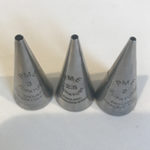
As a recreational artist, I select my brushes and pens by size to balance the width of a line to its related area.
The same is true for Royal Icing extruded through a metal piping tip. If the line-mass balance isn’t right between design elements, the result will be tasty, but clumsy. If an extruded line is too thick for the size of a design, that design’s curves and points might not be well executed. If too thin, possibly the curves and points can’t be seen.
Like with brushes and ink, the best way to determine the extrusion sizes you need is to experiment with decorating tips. (See How to Test Royal Icing for Consistency as a reference.)
Round Metal Tips Used for Royal Icing
The icing tip sizes you use dictate the balance of your design. Using big tips to outline 5-inch cookies might look great, but if you use that same tip on 3-inch cookies, the result might be clumsy. Small tips produce delicate lines that are stunning on small cookies, but can get lost on big ones.
The tip size you use also dictates how successfully you flood icing in an area. If your tip is too small for a large area, part of your flooding will crust (harden) before finishing. If it is too large, chances are you’ll pump too much icing into your boundary, overflowing its edges.
For this article, I tested a range of tip sizes from #3 down to #1, all PME tips. These numbers are comparable to other brands, but hole circumferences between brands differ.
To set up the experiment, I traced three nested cutters at 3.3-, 2.2-, and 1.1-inch. I then placed my drawings under a sheet of clear plastic, and proceeded to pipe outlines using each of my tips. (Search for “clear craft plastic” on any site that sells craft supplies.)
Note: Because of the differences in computer and cell phone monitors, the pictures here are relative to my tracings, but are not displayed as the actual size.
To begin the experiment, I piped a straight line using each one of my piping tips.
Immediately, I could see the greatest similarities were between tip #3 and #2.5, tip #2 and #1.5, and then #1 alone.
Note: Use a pasteurized or whole egg white Royal Icing recipe, possibly with a dash of corn syrup, when working with very small tips to reduce the chance of clogging. Further experimentation is up to you.
Two Piping-bag System
To save time when working with multiple tips, I use a disposable piping bag fitted with a tip coupler to hold the tip. Royal Icing goes into a second bag which fits inside of the first. The photo below shows the two bags side-by-side. Cut the tip off the second bag and fit the bag into the first. This process usually leaves the outer bag fairly clean.
A benefit to using a two-bag system is that if there is a time-lag between piping tasks, you can prevent the icing from drying out by removing the inner bag and sealing the opening by folding and clipping. You can also remove, wash, and return the tip on the outer bag, thus eliminating piping bag and icing waste.
Examples of Royal Icing Extrusion Sizes
The following pictures show the results of outlining a 3.3-inch pattern using a #3 and #2 tip, with the difference between them obvious. The thicker one would be great for creating a dam in which to flood icing, and the thinner one would look more interesting on an already flooded surface.
Smaller perimeters also require different tip considerations:
- The #3 tip makes an extrusion that is too thick for a 1.1-inch perimeter, but is OK for all 2.2-inch perimeters.
- The #2 tip makes an extrusion that looks good on all 2.2-inch perimeters, but barely works on the 1.1-inch perimeter.
- The #1 tip is the only one that looks good on the 1.1-inch perimeter.
To summarize, one cookie design might require different size piping tips and it is up to you to plan which ones are best. Testing on clear plastic like seen here is efficient and doesn’t waste cookies or icing.
Metal Piping Tips Used for Royal Icing Flooding
You also need to consider piping tip sizes for your flooding tasks.
If your tip is too small for a large area, your icing will start crusting before you finish, which causes ripples. If it is too big, you might accidentally pump so much icing into the area that it overflows the design’s boundaries.
When you use the two-bag system, if you find your flood consistency too wet (or maybe too dry), you can remove the inner bag, squeeze out the icing, remix it, then return it to the existing (or new) inner-bag. I have even been known to change colors in this way without any trouble. This reduces waste and the need for a lot of piping tips.
I usually use a #5 tip to flood a 3-or-4-inch cookie surface and a #3 tip for smaller areas. If the area is very small, I might drop to a #2.
In this example, I flooded the 2.2-inch outline by using the #5 tip.
Buying Metal Piping Tips
The type of decorative tips demonstrated here are called “round” or “writing” tips.
I like PMI tips because they are seamless and rarely stain, but they must usually be ordered online unless you live by a specialty shop.
Wilton tips are commonly found in hobby shops, but not in all sizes. If you want to standardize on a range of Wilton tips, you need to order online.
Consider other tip manufacturers, such as Ateco, but no matter what you pick, buy seamless tips as they make the best extrusions.
When you buy online, it is easy to get confused about tip size because photos make very large and small tips look like the same size. Cookie-sized round tips are commonly numbered 000 through 10, with #2 through #5 common. Confusingly, Ateco has an 800-series set which refers to numbers 0 to 9, all of which are too large for your cookie needs.
Very tiny tips with numbers like 000 and 00, extrude spider-web-like lines and I have yet to find a practical reason to use them.
Alternatives to Metal Piping Tips
Do you actually need tips?
Some Royal Icing artists snip the tip off disposable plastic cones and set right to work, usually on 5-inch or larger cookies. Hand-rolled parchment cones can be used for very delicate work, but the people who use them have much more skill than I do.
Rest assured, however, that metal tips will provide excellent extrusions for all your piping needs reliably every time you use them.
Links
- A Tip about Tips, by Sweet SugarBell, May 10, 2012: Demonstrates the differences between brands related to tip size
- Decorating by Numbers, by CakeCentral. This site has the best collection of piping tips labeled by size that I’ve ever seen!
- Decorating Bag Tips, by Wilton. Short article that describes tip categories.
- Videos on How to Use Piping Tips: Note that Royal Icing demands attention to consistency depending on what tip and tip size you use. You can, however, learn how to use tips from demonstrations using butter cream frosting, although consistency information will not be the same.
- How to Decorate with Royal Icing – Top Ten Tips, by Sweetopia. Excellent information, plus a video, on how to use different sized round tips to apply Royal Icing decorations on sugar cookies.
- Ateco Pastry Tip Examples: Page down on this PDF file to see photos of Ateco’s pastry tips in the sizes discussed in this article, plus the rest of their line.
- The Restaurant Store: While The Restaurant Store doesn’t cover all brands, it does organize and display an extremely wide-range of decorating supplies. Browse it and be amazed at what you didn’t know was available that you suddenly realize you need!
- Plastic Food Storage Solutions: Also at The Restaurant Store are food storage containers that are much larger than you might find at a local Target or Walmart. Because of surface areas, large rectangular containers can offer the perfect solution to storing layers of decorated sugar cookies.
Questions? Comments? Additions? Corrections? Write to Karen Little at Karen@Littleviews.com
Written for Littleviews-Crafts.com by Karen Little, publisher, on July 13, 2019. All rights reserved, but feel free to re-publish this article after contacting Karen so she knows where to find it.
Royal Icing: Humidity and Royal Icing Storage (Updated 6/5/19)
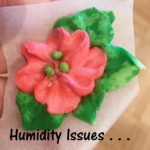
Humidity, whether present when you decorate with Royal Icing, when you serve your decorated cookies, or when you store your icing transfers or cookies themselves, will ruin your work.
This article is about how to prevent problems related to humidity, and possibly how to fix damaged icing or cookies due to humidity and condensation. The good thing about decorating with Royal Icing, however, if all goes wrong, you can always eat your work.
Why Condensation Forms
Air contains water, which we know of as “water vapor.” Condensation transforms the vapor (or gas) in the air into physical water.
In a high humidity environment, water vapor gets absorbed into porous surfaces such as cloth, wood, and yes, baked goods like cookies. This makes these objects damp. On non-porous surfaces, you’ll see thin traces of puddled water.
Sugar cookies as well as Royal Icing soak up the results of condensation. Unfortunately, the best sugar cookies are crisp, a condition that can only be achieved in low humidity. Even if you bake and ice your cookies in an environment with an ideal humidity, shipping and serving environments whose humidity and/or heat is high can ultimately change cookie and icing textures.
Example: Baked products (bread, cookies, pastry) sold outside at many farmer’s markets tend to be moister than when sold in a climate-controlled bakery.
Condensation on Frozen and Refrigerated Cookies
If you froze your cookies and find that they become moist or wet when defrosting at room temperature, it is because condensation (water) forms when humid (wet), atmospheric air contacts a cold surface. As air cools against your frozen package, it releases its moisture which appears on and in your package as water drops or puddles.
Always defrost frozen cookies with lids off in your refrigerator (which, if working correctly, has low humidity inside). Check periodically to make sure that moisture isn’t forming on or in your package as it defrosts. If it is, wipe it off!
Hopefully, your kitchen’s atmospheric air is not humid when you remove your cookies from refrigeration. If it is, a similar problem occurs, with your cookies quickly soaking up the newly released moisture. (See more information in the “Solutions” sections at the end of this article.)
Other Problems
- If your environment is not air conditioned, avoid decorating cookies when the humidity is over 70%: High humidity softens sugar cookies and prohibits icing from quickly drying, leading to damp icing that causes colors to bleed into each other.
- Even if it is cool out, but the humidity is high, consider running your air conditioner to lower your household humidity. Wear a sweater if needed.
- If possible, use a dehumidifier in your work area if moisture is an ongoing problem.
- Never put a plate of beautifully decorated cookies out in a hot, high-humidity atmosphere (like at a lake-side picnic) as they will turn soft.
- If you transport cookies, do not do it in a hot environment, even if your cookies are tightly packaged, as butter melts, causing the sugar cookies to soften.
- If you transport cookies by mail, make sure every cookie is completely dry and packaged in some type of air-tight container. Consider placing a silicon “anti-humidity” packets in the container, too.
- Do not refrigerate or freeze Royal Icing or cookies without proper preparations, as discussed below.
- Do not store Royal Icing or cookies if they have already started to soften, a condition that indicates that they are too moist.
The photo below shows what high humidity can do to Royal Icing:
The darker the colors, the more evidence of how moisture condensation from high humidity can be seen. In the above photo, notice the areas where the dark green bled into the pink. The bleeding does not appear as much between compatible pastel colors, but it still exists, as seen below:
Solutions
Under all circumstances, invest in an inexpensive humidity gauge and consult it before you start baking, decorating, storing, or defrosting cookies.
Ideally, you’ll protect your iced cookies and serve fresh products within a day or so of completion. If, however, you must store your cookies for days or weeks, but your atmosphere is not perfect, try these solutions:
- If your non-iced cookies start to soften, lightly re-bake them at a very low (100 degree or under) temperature. Perhaps heat your oven to 200, turn it off, then insert your cookies and let them sit for a few minutes. You’ll need to test the procedure that works best for you. If your cookies are still soft, boost the temperature.
- I do not own a food dehumidifier, but I suspect if you have one, it would work well. Most home food dehumidifiers are small, so if space matters, experiment between it and the oven method. A recent comment exchange on Julia Usher’s Facebook Group discussed the Chefman Food Dehydrator Machine. The woman who highly recommended this machine lives in New Jersey where the wetlands and coastal areas influence the atmosphere, so I’m inclined to believe her.
- For a few days, you can store your cookies in an air-tight container placed in a dry, cool area.
- If you must refrigerate or freeze your iced cookies:
- Cool your cookies and its containers to the temperature of the refrigerator or freezer.
- Quickly package your cookies. Your objective is to have the least amount of open area in your packaging.
- If possible, use vacuum packaging to remove the extra air (which contains water vapor) from your package.
- Before closing your package, once again cool it to a refrigerator or freezer temperature, then close it tightly or vacuum seal it.
- When ready to use, bring it to room temperature slowly. If you froze your package, open it and let it defrost in the refrigerator. If you refrigerated it, open and let your package sit in the refrigerator for an hour or so before introducing it to kitchen’s environment.
Note: Make sure your refrigerator and freezer work properly as equipment with poor sealing or clogged draining can have interior high humidity which causes the condition known as “sweating.”
For further protection, include food-safe silicon packets, such as available in this assortment sold on Amazon and other online retailers, which absorb moisture. Do not, however, put these directly against the cookies.
Silicon must not be eaten or mistaken for food, so obviously take care when storing treats if children are around. “Food Safe” silicon packages might answer your need, but still keep all packets out of the hands of kids. If, however, you have taken precautions, but are still concerned, paste a Mr. Yuck or other poison-alert sticker on each one, like seen below:
Shipping
It is easier to ship chewy cookies, than crispy. For general advice about shipping, read “5 Mistakes to Avoid When Packing & Shipping Cookies by Maggie Battista,” first published on TheKitchen.com, December 2016.
If your package is very delicate and important, consult online information on “packaging food for mailing.”
Links
- “Food Safe” silicon packets, among many brands, are sold on Amazon and other online shops.
- Mr. Yuck or other poison stickers.
- A general Internet search for “food dehumidifiers” turns up many potential solutions.
- 5 Mistakes to Avoid When Packing & Shipping Cookies by Maggie Battista,” first published on TheKitchen.com, December 2016.
- The Chefman Food Dehydrator Machine, as recommended by a participant on Julia Usher’s Facebook Group.
- Google searches:
- How Do Bakeries Handle Humidity – general search
- The Importance of Humidity Control in Bakeries – PolygonGroup.com
- 5 Tips For Successful Baking in High Humidity – FarmersAlmanac.com
- Relative Humidity – BakerPedia.com
Questions? Comments? Additions? Corrections? Write to Karen Little at Karen@Littleviews.com
Written for Littleviews-Crafts.com by Karen Little, publisher, on May 12, 2019. All rights reserved, but feel free to re-publish this article after contacting Karen so she knows where to find it.
